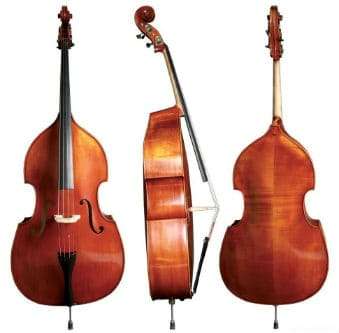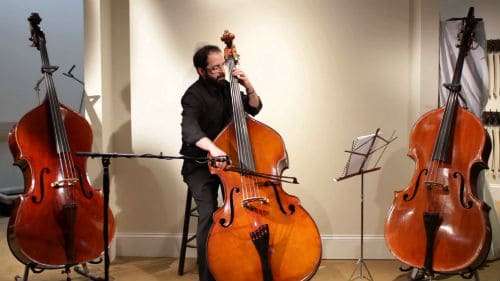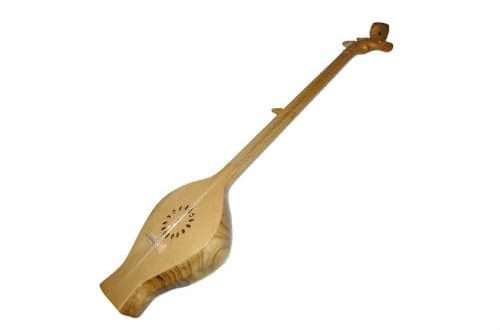
Double bass: description of the instrument, composition, history, sound, use
Contents
The double bass is a musical instrument belonging to the family of strings, bows, it is distinguished by its low sound and large size. It has rich musical possibilities: suitable for solo performances, it occupies an important place in a symphony orchestra.
Double bass device
The dimensions of the double bass reach 2 meters in height, the instrument consists of the following parts:
- Frame. Wooden, consisting of 2 decks, fastened on the sides with a shell, an average length of 110-120 centimeters. The standard shape of the case is 2 ovals (upper, lower), between them there is a narrower space called the waist, on the surface there are two resonator holes in the form of curls. Other options are possible: pear-shaped body, guitars and so on.
- Neck. Attached to the body, strings are stretched along it.
- String holder. It is located at the bottom of the case.
- String stand. It is located between the tailpiece and the neck, approximately in the middle of the body.
- Strings. Orchestral models are equipped with 4 thick strings made of metal or synthetic materials with obligatory copper winding. Rarely there are models with 3 or 5 strings.
- Vulture. The end of the neck is crowned with a head with tuning pegs.
- Spire. Designed for large-sized models: allows you to adjust the height, adjust the design to the growth of the musician.
- Bow. An essential addition to the contrabass. Due to the heavy, thick strings, playing it with your fingers is possible, but difficult. Modern double bassists can choose from 2 types of bows: French, German. The first has a greater length, surpasses the opponent in maneuverability, lightness. The second is heavier, shorter, but easier to manage.

A mandatory attribute is a cover or case: transporting a model that can weigh up to 10 kg is problematic, the cover helps prevent damage to the case.
What does double bass sound like?
The double bass range is approximately 4 octaves. In practice, the value is much less: high sounds are available only to virtuoso performers.
The instrument produces low, but pleasant to the ear sounds, which have a beautiful, specifically colored timbre. Thick, velvety double bass tones go well with the bassoon, tuba, and other groups of orchestral instruments.
The structure of the double bass can be as follows:
- orchestral – the strings are tuned in fourths;
- solo – string tuning goes a tone higher.

Types of double basses
Instruments vary in size. Overall models sound louder, miniature ones sound weaker, otherwise the characteristics of the models are similar. Until the 90s of the last century, double basses of reduced sizes were practically not made. Today you can buy samples in sizes from 1/16 to 3/4.
Small models are designed for students, students of music schools, for musicians playing outside the orchestra. The choice of model depends on the height and dimensions of a person: on an impressive structure, only a musician of large build can fully play music.
The reduced instruments look identical to full-fledged orchestral brothers, differing only in timbre coloring and sound.

Double bass history
History calls the double bass viola, which spread throughout Europe during the Renaissance, the predecessor of the double bass. This five-string instrument was taken as a basis by the master of Italian origin Michele Todini: he removed the lower string (the lowest) and the frets on the fingerboard, leaving the body unchanged. The novelty sounded differently, having received an independent name – double bass. The official year of creation is 1566 – the first written mention of the instrument dates back to it.
The development and improvement of the instrument was not without the Amati violin makers, who experimented with the shape of the body and the dimensions of the structure. In Germany, there were very small, “beer basses” – they played them at rural holidays, in bars.
XVIII century: the double bass in the orchestra becomes a constant participant. Another event of this period is the appearance of musicians playing solo parts on the double bass (Dragonetti, Bottesini).
In the XNUMXth century, an attempt was made to create a model that reproduces the lowest possible sounds. The four-meter octobass was designed by the Frenchman Zh-B. Vuillaume. Due to the impressive weight, exorbitant dimensions, the innovation was not widely used.
At the beginning of the twentieth century, the repertoire, the possibilities of the instrument expanded. It began to be used by performers of jazz, rock and roll, and other modern styles of music. It is worth noting the appearance in the 20s of the last century of electric basses: lighter, more manageable, more comfortable.

Play technique
Referring to the stringed types of instruments, the double bass suggests 2 possible ways to extract sounds:
- bow;
- fingers.
During the Play, the solo performer stands, the orchestra member sits next to him on a stool. The techniques available to musicians are identical to those used by violinists. The design features, the serious weight of the bow and the instrument itself make it difficult to play passages and scales. The most commonly used technique is called pizzicato.
Available musical touches:
- detail – extracting several consecutive notes by moving the bow, by changing its direction;
- staccato – jerky movement of the bow up and down;
- tremolo – repeated repetition of one sound;
- legato – a smooth transition from sound to sound.

Using
First of all, this instrument is an orchestral one. His role is to amplify the bass lines created by the cellos, to create a rhythmic basis for the playing of other string “colleagues”.
Today, an orchestra can have up to 8 double basses (for comparison, they used to be content with one).
The origin of new musical genres made it possible to use the instrument in jazz, country, blues, bluegrass, rock. Today it may well be called indispensable: it is actively used by pop performers, musicians of non-standard, rare genres, most orchestras (from military to chamber ones).


Watch this video on YouTube





